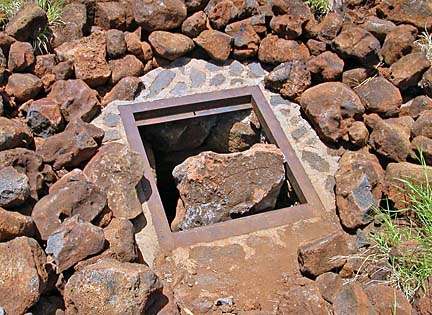State secures entrance to Big Island burial cave
The move will restrict access as investigators look at how artifacts were put up for sale
Honolulu Star-Bulletin
Friday, August 27, 2004
By Sally Apgar
sapgar@starbulletin.comThe state Department of Land and Natural Resources announced yesterday that it has secured access to Kanupa Cave, a sacred burial site that allegedly was illegally opened on the Big Island.
Department officials declined to describe the security measures.
For the last few weeks, agents with the U.S. Department of the Interior have been investigating how artifacts that were allegedly reburied in the cave last November were put up for sale.
The items, believed to have come from the Bishop Museum and Peabody Essex Museum in Salem, Mass., had been repatriated to several native Hawaiian organizations.
No suspects have been charged or arrested.
In a written statement yesterday, Department of Land and Natural Resources Director Peter Young said, "We have secured the entrance to Kanupa Cave and will restrict all access in order to prevent further desecration or contamination of evidence."
Young said the state is working to secure the cave, which is located on state-owned land, in cooperation with federal investigators and the rancher who leases the land.
SALLY APGAR / SAPGAR@STARBULLETIN.COM
Kanupa Cave in Kohala on the Big Island showed signs of
disturbance Saturday during a visit by the Star-Bulletin.Late last week, Hui Malama I Na Kupuna O Hawaii Nei, one of the lead organizations in the repatriation of human remains and artifacts, hired private investigator Terry Pennington of Goodenow & Associates to visit Kanupa Cave.
In a statement yesterday, Hui Malama said the investigator "discovered that our worst fears had come true -- Kanupa Cave was broken into. Apparently over the course of at least several days, highly motivated thieves worked their way through multiple protective measures that we put in place to secure" the items reburied in the cave.
The statement also said, "Whoever desecrated Kanupa Cave violated Hawaiian kapu (sacred law) regarding the sanctity of a burial site and state laws regarding historic burial sites and must be apprehended."
Hui Malama asked the DLNR this week to investigate the opening of Kanupa cave and was told that the state agency was already cooperating in the federal investigation.
Several members of Hui Malama said yesterday that it is the responsibility of the DLNR to investigate the alleged grave robbery and to secure the cave.
Charles Maxwell, a Hui Malama senior board member, criticized state and federal officials for failing to adequately protect burial caves on all Hawaiian islands.
"If this was the Arlington cemetery, there would be an outcry," he said, adding, "but because we Hawaiian ... nobody does nothing. It's pathetic. It's frustrating that the State of Hawaii does not protect our cultural sites."
But other native Hawaiians argue that Hui Malama took the responsibility of reburying the bones and artifacts and thus assumed the responsibility of securing the cave.
"These people are the self-appointed guardians or kahu of the caves. They cannot be absolved, by tradition, of their responsibility to guard the caves," said La'akea Suganuma, a representative of the Royal Hawaiian Academy of Traditional Arts, a group that has been at odds with Hui Malama over the reburial of 83 items stolen by David Forbes from a cave in Kawaihae in 1905 and purchased by the Bishop Museum.
Suganuma said, "In the old days, if something happened to a cave, the perpetrator was taken to task, but so was the kahu that was sworn to protect the cave."
He added: "Hui Malama took the responsibility and failed. They might escape the laws of man but not the laws of tradition and the spiritual world."
Security at the caves has long been an issue. In 1989, when archaeologist Hallett Hammatt surveyed the Kanupa and Forbes caves for the state, he found the caves "had been heavily visited and desecrated. There were candles on shelves and litter and bottles left behind."
In a 1999 letter to the Native Hawaiian Historic Preservation Council, Bobby Camara, a cave resource specialist with the National Park Service, wrote, "Because of the large amounts of money that these items could bring on the black market ... certain unscrupulous dealers, collectors and thieves would consider gates, constructed sealing walls or other security measures a challenge, not a barrier."
Hui Malama I Na Kupuna O Hawaii Nei
© 2004 Honolulu Star-Bulletin -- http://starbulletin.com
Original article URL: http://starbulletin.com/2004/08/27/news/story3.html
Ho`iho`i Mai
Return
